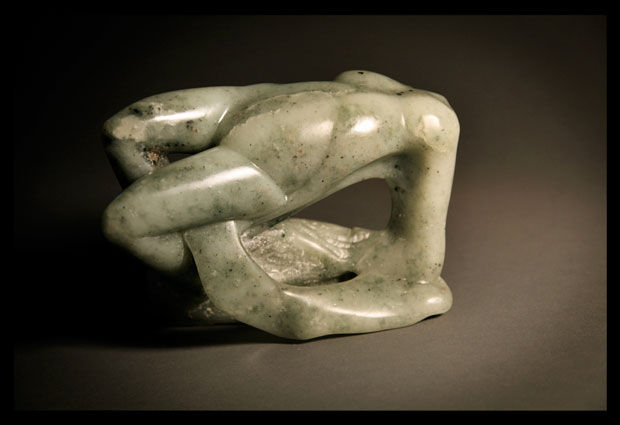Layers of meaning in ‘Humankind’ exhibition
Published July 25, 2016
When I walked into the “Humankind” exhibition at The Foundry Art Centre in St. Charles, I was surprised at its depth. Most of the work seems straightforward, until you slow down and look more closely. Whole worlds hide just under the surface.
One of these worlds is contained within “Zoey’s First Heartbeat” by Ted Rips. The artist created this 2” x 21” x 4” piece from glass and steel. Translucent ocean-blue glass depicts a 12-week-old fetus’ heartbeat, formed in the shape of beats on a heart monitor. Read from left to right, the beats start out small and irregular, then increase to high peaks at regular intervals. The heart beats continuously from the very beginning of life to the very end. Rips captured its rhythm and immortalized it in sculpture.
The beginning of life is central to Jose Terrazas’ small soapstone sculpture titled “Venus”. Terrazas reinterpreted the myth of the birth of Venus rising out of the ocean: instead of a beautiful goddess, this Venus is awkward, unsure, uncomfortable. Her contorted headless torso is entwined with and at the same time rises out of the green ocean from which she is made. She arches her back, her arms and legs supporting her even as they merge with the ocean. Her body seems to be caught not only in mid-fall but also at the moment of her creation. She is unsteady, trapped between the water and her own identity. Her headless state implies that her identity hasn’t yet formed. Terrazas’ piece evokes the temporary gap that exists between the creation of our bodies and of our identities.
Chadric Devin focuses on identity in his piece “Bench”, made up of five gold-toned Van Dyke brown prints on Kozo. In each print, a basketball player sits on a metal folding chair, his back to us. The backgrounds are dark. The players lean forward, which obscures or hides their heads. Each hunched figure, alone in his little box, evokes senses of depression, isolation, shame, and embarrassment. Why aren’t these men playing? What did they do wrong? The artist was pressured by his stepfather and community to play basketball. He explores constructions of masculinity “and the ways in which boys and men are expected to interact and perform their gender.” He says, “When [I am] on the bench…I am obsolete, different, and not good enough.” Once we find our identity, we must contend with external forces which may not allow us to be who we are.
“Humankind” is on view at The Foundry Art Centre through Aug. 5. The Foundry is located at 520 North Main Center in downtown St. Charles. Gallery hours are Tuesday through Thursday, 10 a.m. to 8 p.m.; Friday and Saturday, 10 a.m. to 5 p.m.; Sunday, noon to 4 p.m.; and closed Mondays. For more information, call 636-255-0270 or visit www.foundryartcentre.org.














